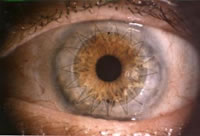 Dr. Garrett uses the latest technology in corneal transplantation.
Dr. Garrett uses the latest technology in corneal transplantation.
Corneal transplantation, also known as corneal grafting or penetrating keratoplasty, is a surgical procedure in which a damaged or diseased cornea is replaced by donor corneal tissue. The tissue comes from a recently deceased individual with no known diseases that could affect the viability of the donated tissue. The cornea is the clear part of eye in front of the iris and pupil.
The most common type of corneal transplant is called “penetrating keratoplasty.” During this procedure, Dr. Garrett removes a small round piece of the cornea. The donated cornea is then sewn into the opening of the eye. The stitches are removed at a follow-up visit.
DSEK/DMEK Corneal Surgery
In some eye conditions, the innermost layer of the cornea called the “endothelium” is damaged. This causes the cornea to swell, affecting your vision. Endothelial keratoplasty is a surgery to replace this layer of the cornea with healthy donor tissue. It is known as a partial transplant since only this inner layer of tissue is replaced.
There are a few types of endothelial keratoplasty. They are known as:
- DSEK (or DSAEK) — Descemet’s Stripping (Automated) Endothelial Keratoplasty
- DMEK — Descemet’s Membrane Endothelial Keratoplasty
Each type removes damaged cells from an inner layer of the cornea called Descemet’s membrane. The damaged corneal layer is removed through a small incision. Then the new tissue is put in place. Just a few stitches—if any—are needed to close the incision. Much of the cornea is left untouched. This lowers the risk of having the new cornea cells being rejected after surgery.
Some things to know:
- With DSEK/DSAEK surgery, the donor tissue may be easier to transplant and position because it is thicker than the donor tissue in DMEK surgery.
- In DMEK surgery, the donor tissue is thin and can be more difficult to transplant. But, the recovery is quicker because the transplant tissue is thinner.
- Dr. Garrett will choose the type of surgery based on your cornea’s condition.
Not all patients with diseased corneas are candidates for endothelial keratoplasty. These procedures correct corneal endothelial failure, but are not able to correct corneal scarring, thinning, or surface irregularity.

